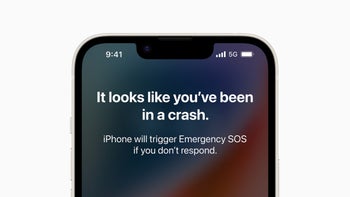Apple's Crash Detection sent 71 notifications to one 911 center last weekend

Last September, while unveiling the iPhone 14 series and the Apple Watch Series 8, the Apple Watch Ultra, and the Apple Watch SE (2022), a new feature was introduced for these devices. Any of these products will detect when you have been in a severe car, SUV, or pickup truck crash. Unless you shut down the process with a tap, after 10 seconds the phone will contact your emergency contacts and give them your current location.
Apple created an ad for the iPhone 14 line based on Crash Detection
Two days after introducing the feature, Apple turned Crash Detection into an ad for the new iPhone 14 line that shows an iPhone flying through the air amid a shower of broken glass. "It looks like you've been in a crash," says the screen. "iPhone will trigger Emergency SOS if you don't respond." Apple states that the Crash Detection feature is driven (no pun intended) by advanced Apple-designed motion algorithms trained with over a million hours of real-world driving and crash record data."


We should point out that a similar feature was made available to the Google Pixel line in 2019. Regardless, while this does sound like quite a useful, helpful, and potentially life-saving feature, technology can also backfire every now and then. For example, The Colorado Sun (via GSMArena) reported on Monday that at the Summit County 911 Center, dispatchers received an incredible 71 automated crash notifications just this past weekend from skiers who were carrying an iPhone or wearing one of the three newest Apple Watch models.
The notifications came in from the area's four ski areas but none of the notifications received had to do with a real emergency. Skiers making quick stops and falling into the snow set off the Crash Detection feature even though there was not one true emergency in the bunch. And if Crash Detection wasn't set off by a fall into the snow, the Apple Watch's fall detection feature, which essentially has a similar process to run through when someone wearing the timepiece hits the ground, was responsible for unnecessary notifications.
None of the 71 notifications could be simply disregarded. And if the device owner did not respond to a return call, a special operations deputy had to contact ski patrol to visit the location where the impact happened to make sure no one was seriously hurt. This was a time-consuming activity but had to be done.
None of the 71 notifications from iPhone and Apple Watch users was an emergency
Trina Dummer, the interim director of the Summit County 911 Center, said, "We are not in the practice of disregarding calls,. These calls involve a tremendous amount of resources, from dispatchers to deputies to ski patrollers. And I don’t think we’ve ever had an actual emergency event." All 71 notifications were set off by an impact...into the soft snow.
And since calls are handled by the 911 Center based on the time the call is received, a bogus accident that sends out a notification from an Apple device could delay the arrival of medical help to a real emergency in the area. Dummer notes that "We are absolutely diverting essential resources away from people who need it toward a feature on a phone." A comment worded like that sounds like someone is upset with Apple.
Another 911 Center, this one in Pitkin County, receives 15 to 20 calls a day from Apple's Crash Detection feature that come from the county's four main ski areas. The 911 Center's director, Brett Loeb, says every notification generates a return call although sometimes a skier's phone is too deep inside a coat pocket for the user to hear it ringing. At that point, the ski patrol has to check out the area which delays things.
Similar to what happened in Summit County, in Pitkin County not one notification from Apple's Crash Detection was the result of a real emergency.










Things that are NOT allowed: